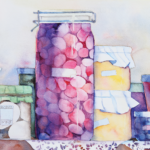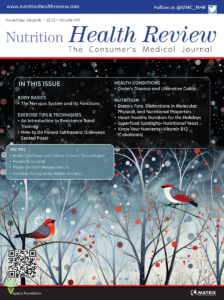 As the summer winds down, you may find yourself seeing less and less of some of seasonal produce—melons, berries, citrus, and some herbs. Luckily, just because you’re parting with long summer days doesn’t mean you have to do the same with your favorite seasonal fruits and vegetables. There are several methods of preserving foods, including canning (jarring), freezing, dehydration (drying), fermentation, pickling, curing, and irradiation.1 While this can be a fun family activity, it is critical that food preservation be done correctly. Food-borne illnesses, or food poisoning, often involve raw produce, dairy products, or meat that haven’t been properly stored or preserved.2 Here are the four basic food preservation methods you can do at home.
As the summer winds down, you may find yourself seeing less and less of some of seasonal produce—melons, berries, citrus, and some herbs. Luckily, just because you’re parting with long summer days doesn’t mean you have to do the same with your favorite seasonal fruits and vegetables. There are several methods of preserving foods, including canning (jarring), freezing, dehydration (drying), fermentation, pickling, curing, and irradiation.1 While this can be a fun family activity, it is critical that food preservation be done correctly. Food-borne illnesses, or food poisoning, often involve raw produce, dairy products, or meat that haven’t been properly stored or preserved.2 Here are the four basic food preservation methods you can do at home.
CANNING
Canning (jarring) began in the 1800s and is still a staple in food preservation.3 This process requires careful attention to detail and instructions. Canning involves cooking food in a can or jar after it’s sealed.4 Whether it’s done commercially or in your kitchen, the process, which involves a high temperature and a sterile container, destroys organisms that would flourish if the food was left exposed. When done correctly, canning removes oxygen, destroys enzymes, and prevents the growth of undesirable bacteria, yeasts, and molds.4-5 A key part in safe canning is forming a high vacuum in the containers. These vacuums form tight seals which keep liquid in and air and microorganisms out.3,6,7 Properly canned items can last years before expiring.
FREEZING
People have been using cold temperatures to preserve foods for thousands of years, but freezing didn’t become a mainstay method of food storage in the home until the 1930s when the modern freezer became commonplace.8 Freezing reduces the temperature of the food to slow the rate of chemical and biological reactions that allow microorganisms to grow, resulting in food-spoiling enzyme activity.9 The freezing process depends on the foods being frozen. For example, vegetables must be blanched—briefly submerged in boiling water before freezing.10 The length of preservation time through freezing also depends on the food and the temperature of the freezer. At 0º Fahrenheit, produce can be frozen for up to 12 months, but cured or processed meat will only last up to two months.11 See sidebar “Is It Safe to Refreeze Food?”)
DEHYDRATING/FREEZE DRYING
Drying is one of the oldest methods of preserving food.10 Freeze drying, not to be confused with simple dehydration, involves removing moisture from produce, beans, nuts, and some meats, which hinders bacteria growth. Notably, freeze-dried foods are frozen first, and any remaining iced crystals or vapors are removed with a vacuum.12 The food is then immediately packaged and sealed. While they will not return to their original form, freeze-dried foods quickly reabsorb moisture during meal or food prep.10 Freeze-dried foods are preferable to dehydrated goods because the dehydration process can undermine nutrient content.12,13 Like canning, it is important to carefully follow dehydration/freeze-drying instructions, to avoid mistakes that can cause foods to shrink, change color, or collapsed in structure. This food preservation method can allow food to last between 25 and 30 years when stored in a cool, dry place.13
CURING
People have been curing meats for hundreds of years. One product you may already be familiar with is cured ham, which has been produced for centuries and still relies on the basic stages of salting, drying, and ripening.14 This preservation method involves tightly packing meats in salted containers, which draws out moisture to prevent spoilage, and storing in a cool, dry place.10 This preservation method is relatively safe, as bacteria can’t thrive in the presence of a high amount of salt. However, consuming too many cured products can cause bloating, severe thirst, and a temporary rise in blood pressure. Depending on the type of meat, cured products typically last up to two weeks in the refrigerator and up to three months in a freezer.15
BOTTOM LINE
Preserving food at home can be a fun and family-friendly activity. It’s also a great way to cut back on food waste. However, safety should come first when using any of these methods; make sure you follow instructions as closely as you can to prevent food-borne illness.
For detailed instructions on how to safely preserve foods, visit the National Center for Home food Preservation at https://nchfp.uga.edu/index.html.
SOURCES
1. Numner B. May 2002. Historical Origins of Food Preservation. National Center for Home Food Preservation website. https://nchfp.uga.edu/publications/nchfp/factsheets/food_pres_hist.html. Accessed 27 Jul 2021.
2. CDC. Updated 18 Mar 2020. Food-borne Germs and Illnesses. Center for Disease Control and Prevention website. https://www.cdc.gov/foodsafety/foodborne-germs.html. Accessed 27 Jul 2021.
3. USDA. How Did We Can – An Evolution of the Home Canning Process. United States Department of Agriculture National Library website. https://www.nal.usda.gov/exhibits/ipd/canning/timeline-table. Accessed 27 Jul 2021.
4. Duyff RL. Complete Food and Nutrition Guide. New York City, NY: The Academy of Nutrition and Dietetics; 2017;130.
5. NCHFP. How Canning Preserves Foods. National Center for Home Food Preservation website. https://nchfp.uga.edu/how/general/how_canning_preserves_foods.html. Accessed 27 Jul 2021.
6. McHugh T. 1 Jan 2020. Canning Clarified. Institute of Food Technologists website. https://www.ift.org/news-and-publications/food-technology-magazine/issues/2020/january/columns/canning-clarified. Accessed 27 Jul 2021.
7. CDC. Updated 25 Jun 2020. Home Canning and Botulism. Center for Disease Control and Prevention website. https://www.cdc.gov/foodsafety/communication/home-canning-and-botulism.html. Accessed 27 Jul 2021.
8. Mermelstein NH. 1 Oct 2001. What’s Happening in Freezing Research. Institute of Food Technologists website. https://www.ift.org/news-and-publications/food-technology-magazine/issues/2001/october/columns/products-and-technologies_processing. Accessed 28 Jul 2021.
9. How Does Freezing Preserve Food and Maintain Quality? The European Food Information Council website.Updated 1 Mar 2002. https://www.eufic.org/en/food-safety/article/chilling-out-freezing-foods-for-quality-and-safety. Accessed 28 Jul 2021.
10. Duyff RL. Complete Food and Nutrition Guide. New York City, NY: The Academy of Nutrition and Dietetics; 2017;131.
11. NCHFP. General Freezing Information. National Center for Home Food Preservation website. https://nchfp.uga.edu/how/freeze/freezer_shelf_life.html. Accessed 28 Jul 2021.
12. Nowak D, Jakubczyk E. The freeze-drying of foods – the characteristic of the process course and the effect of its parameters on the physical properties of food materials. Foods. 2020;9(10):1488.
13. The Shelf Life of Freeze-dried Food. Mercer Foods website. https://www.mercerfoods.com/shelf-life-freeze-drying/. Accessed 28 Jul 2021.
14. Nummer BA. May 2002. Historical Origins of Food Preservation. National Center for Home Food Preservation website. https://nchfp.uga.edu/publications/nchfp/factsheets/food_pres_hist.html. Accessed August 2, 2021.
15. Nummer BA, Andress E. Curing and Smoking Meats for Home Food Preservation Literature Review and Critical Preservation Points. Athens, GA: The University of Georgia, Cooperative Extension Service; 2002.





